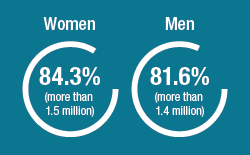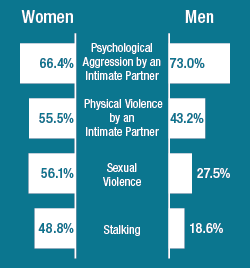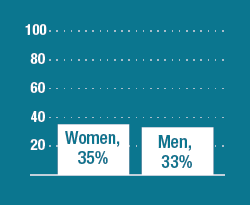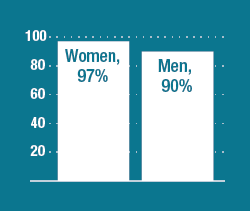This page summarizes the five main findings of a research report that examined the prevalence of violence against American Indian and Alaska Native women and men using a large nationally representative sample from the National Intimate Partner and Sexual Violence Survey (NISVS). [1]
1. Most American Indian and Alaskan Native Adults are Victims of violence.
More than four in five American Indian and Alaska Native adults (83 percent) have experienced some form of violence in their lifetime. That's almost 3 million people who have experienced psychological aggression or physical violence by intimate partners, stalking, or sexual violence.
2. Men and women are victimized at similar rates but in different ways.
American Indian and Alaska Native women and men have been victimized at similar rates (84.3 percent for women and 81.6 percent for men). They have experienced similar levels of psychological aggression and physical violence by intimate partners. But women have experienced significantly higher levels of sexual violence (56.1 percent versus 27.5 percent for men) and stalking (48.8 percent versus 18.6 percent for men).
3. Victimization rates are higher for American Indians and Alaska Natives.
The lifetime victimization rate is 1.2 times as high for American Indian and Alaska Native women as for White women; for men, it is 1.3 times as high.
4. American Indian and Alaska Native female victims are more likely to need services, but they are less likely to have access to those services.
More than two in five American Indian and Alaska Native female victims reported being physically injured, and almost half reported needing services. The services most commonly needed were medical care and legal services. Unfortunately, more than a third (38 percent) were unable to receive necessary services.
Research continues to highlight the disparities in health outcomes and access to health care for American Indians and Alaska Natives. These results highlight the need for additional services for American Indian and Alaska Native victims of crime — a need that was also documented in the Office for Victims of Crime’s Vision 21: Transforming Victim Services — Final Report (pdf, 63 pages).
5. For American Indian and Alaska Natives, interracial violence is more prevalent than intraracial violence.
Although the exact number of victimizations per person is unknown, it is clear that most American Indian and Alaska Native victims have experienced at least one act of violence committed by an interracial individual (97 percent of women and 90 percent of men). Fewer victims (35 percent of women and 33 percent of men) have experienced one or more acts of violence by an American Indian or Alaska Native individual.
This finding offers strong support for the sovereign right of federally recognized tribes to criminally prosecute non-Indian individuals. Until recently, federally recognized tribes did not have this authority, even for crimes committed on tribal lands. This gap in jurisdictional authority provided immunity to non-Indian individuals and compromised the safety of tribal communities. The Violence Against Women Reauthorization Act of 2013 partially corrected this problem by providing special domestic violence criminal jurisdiction to federally recognized tribes. But more progress can be made to provide justice for American Indian and Alaska Native victims.
Findings and conclusions of the research reported here are those of the authors and do not necessarily reflect the official position or policies of the U.S. Department of Justice.
The content on this page is not intended to create, does not create, and may not be relied upon to create any rights, substantive or procedural, enforceable at law by any party in any matter civil or criminal.





